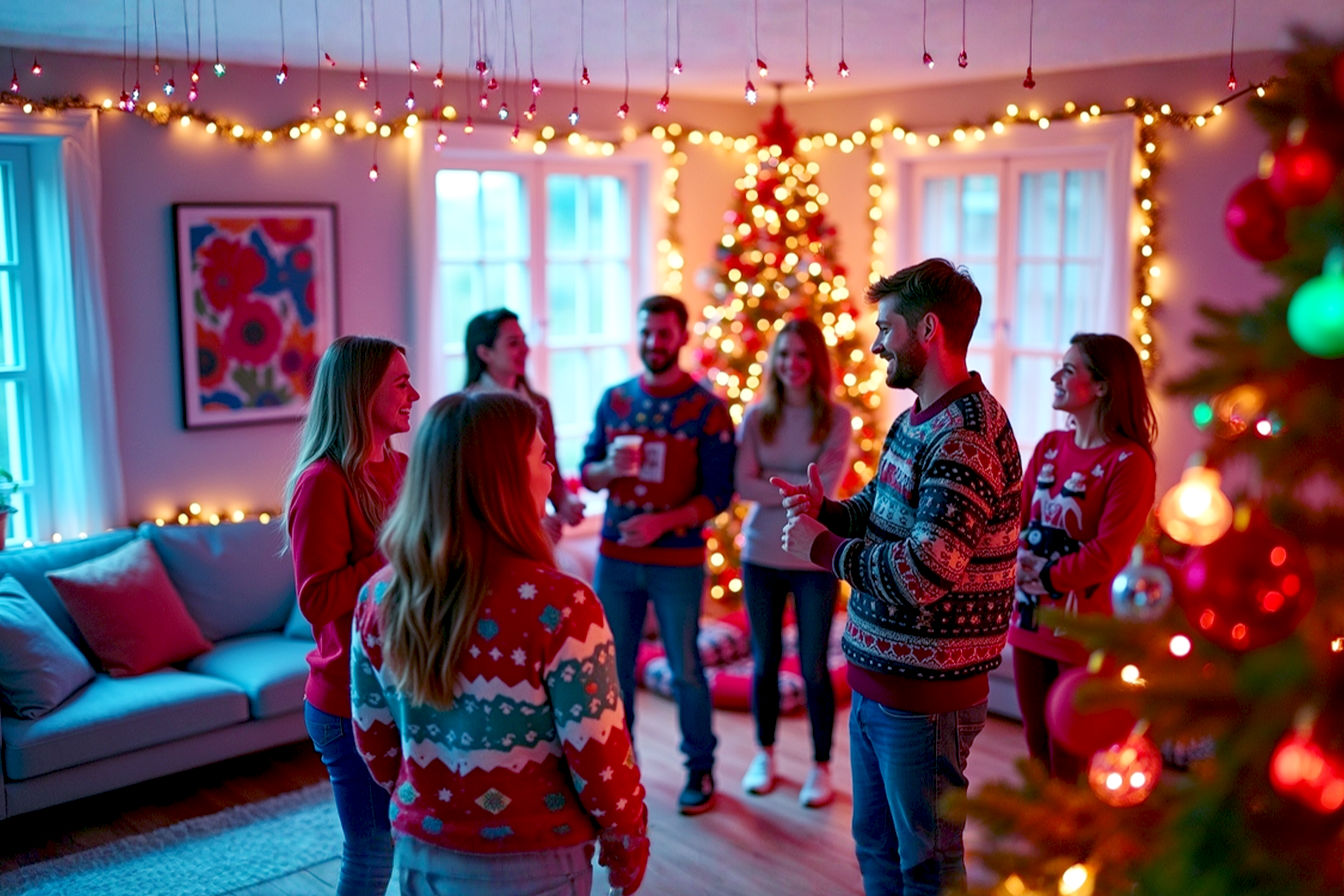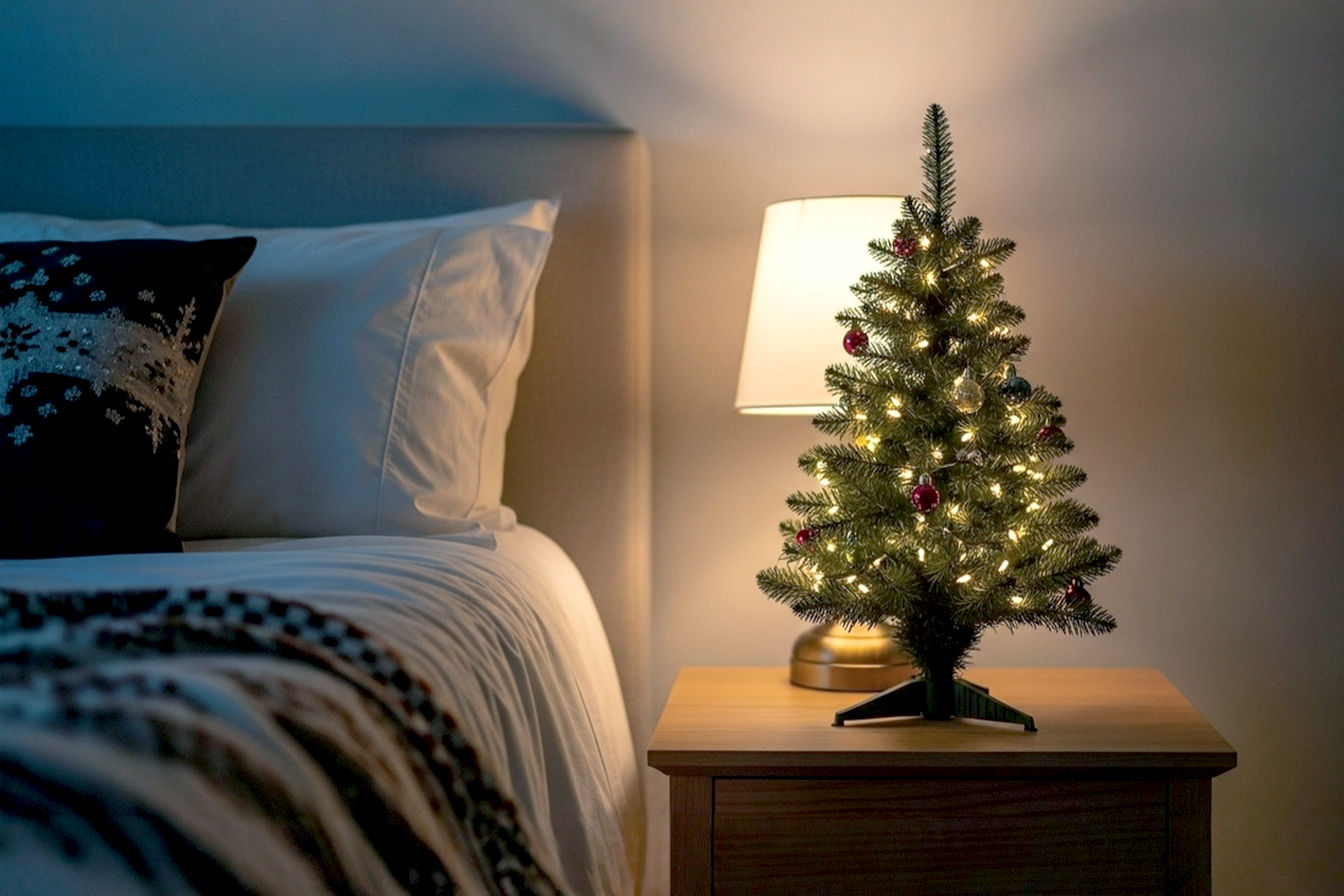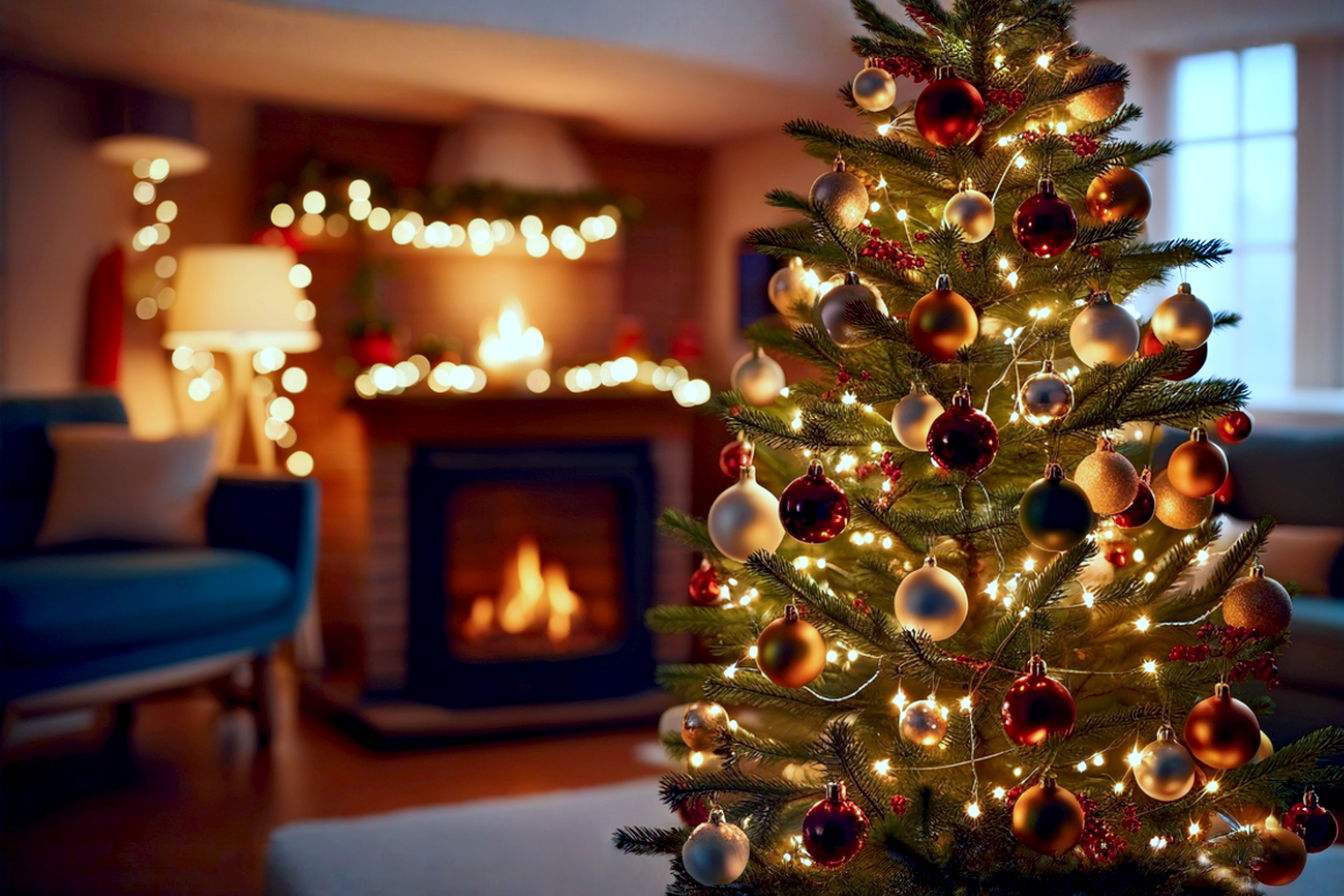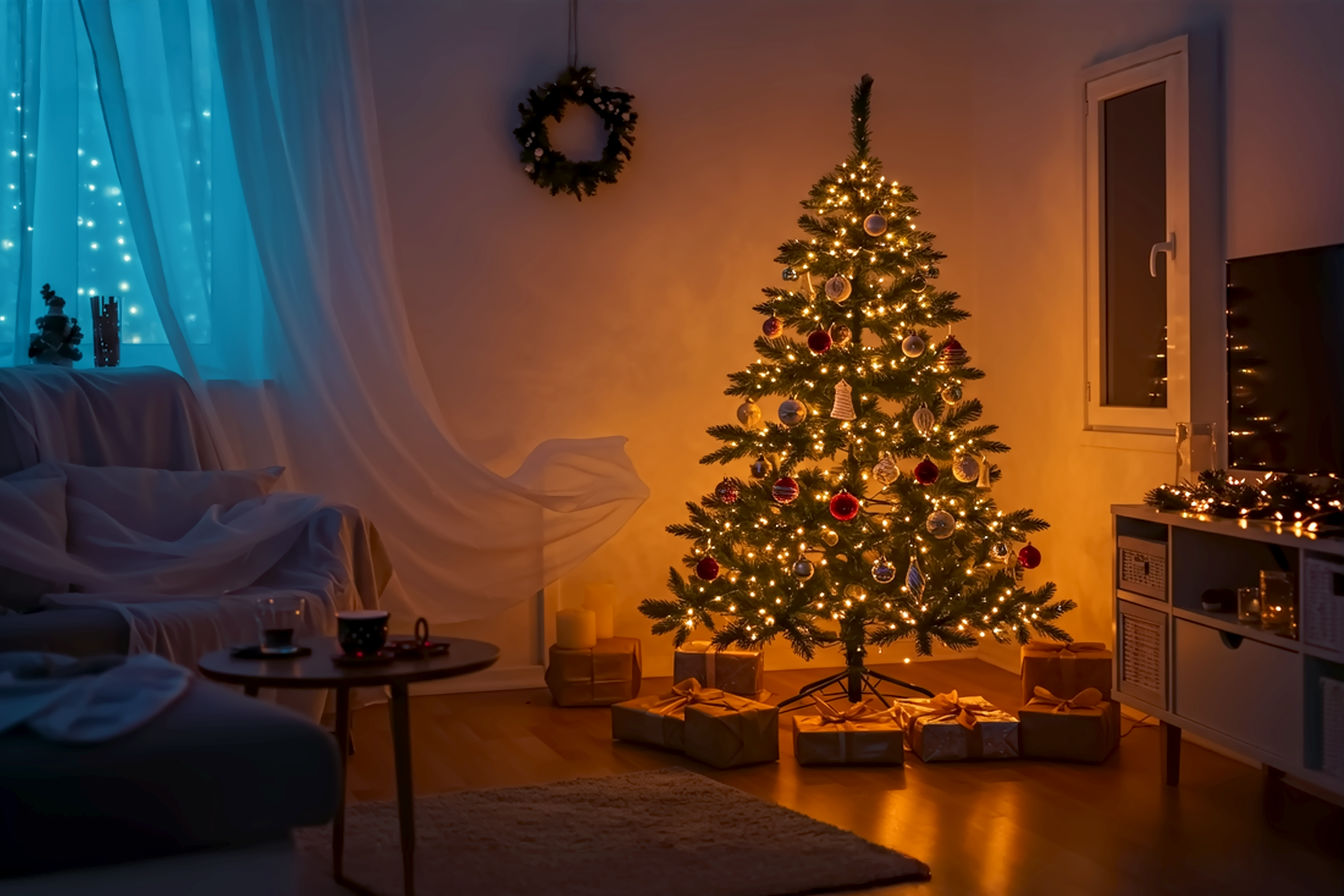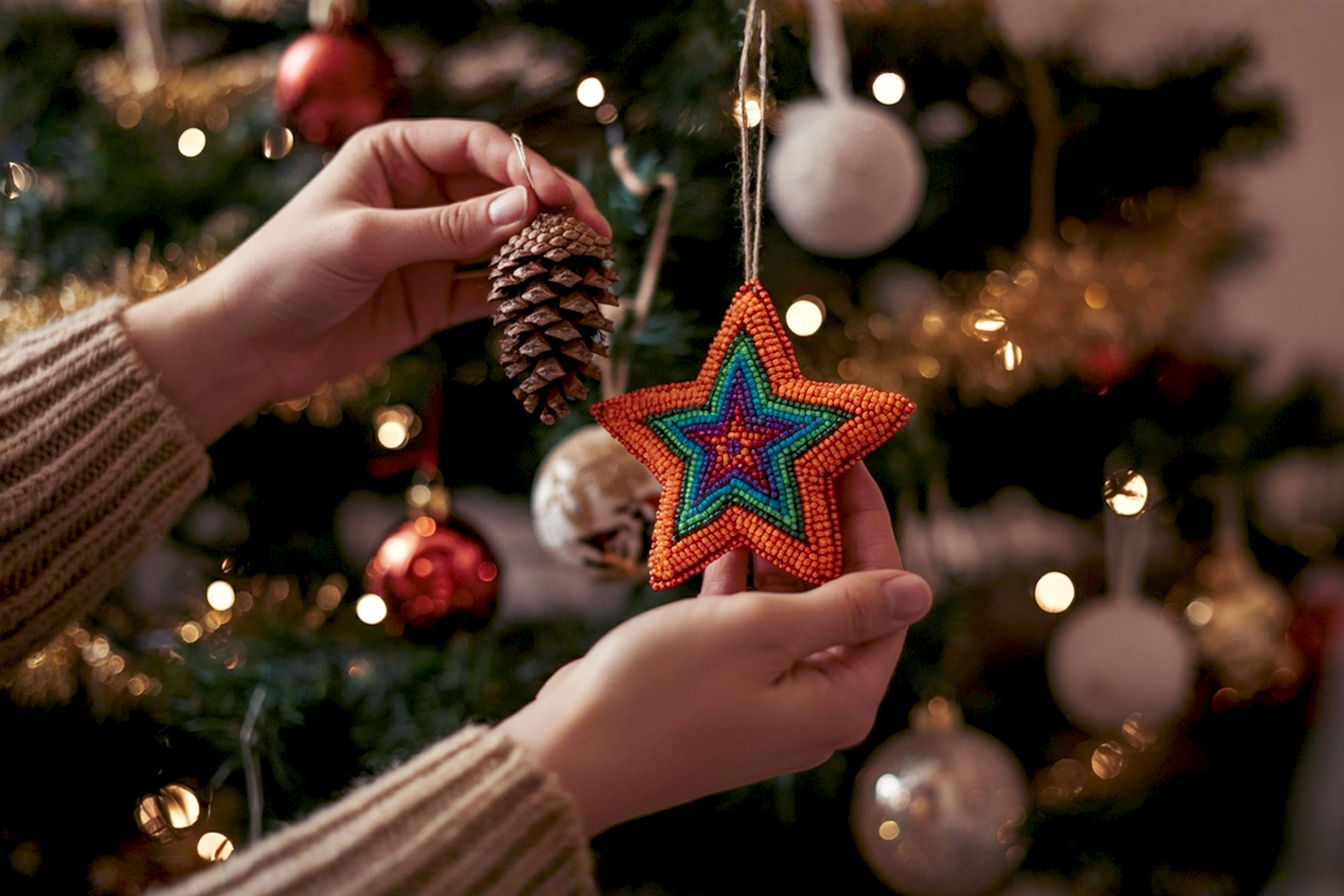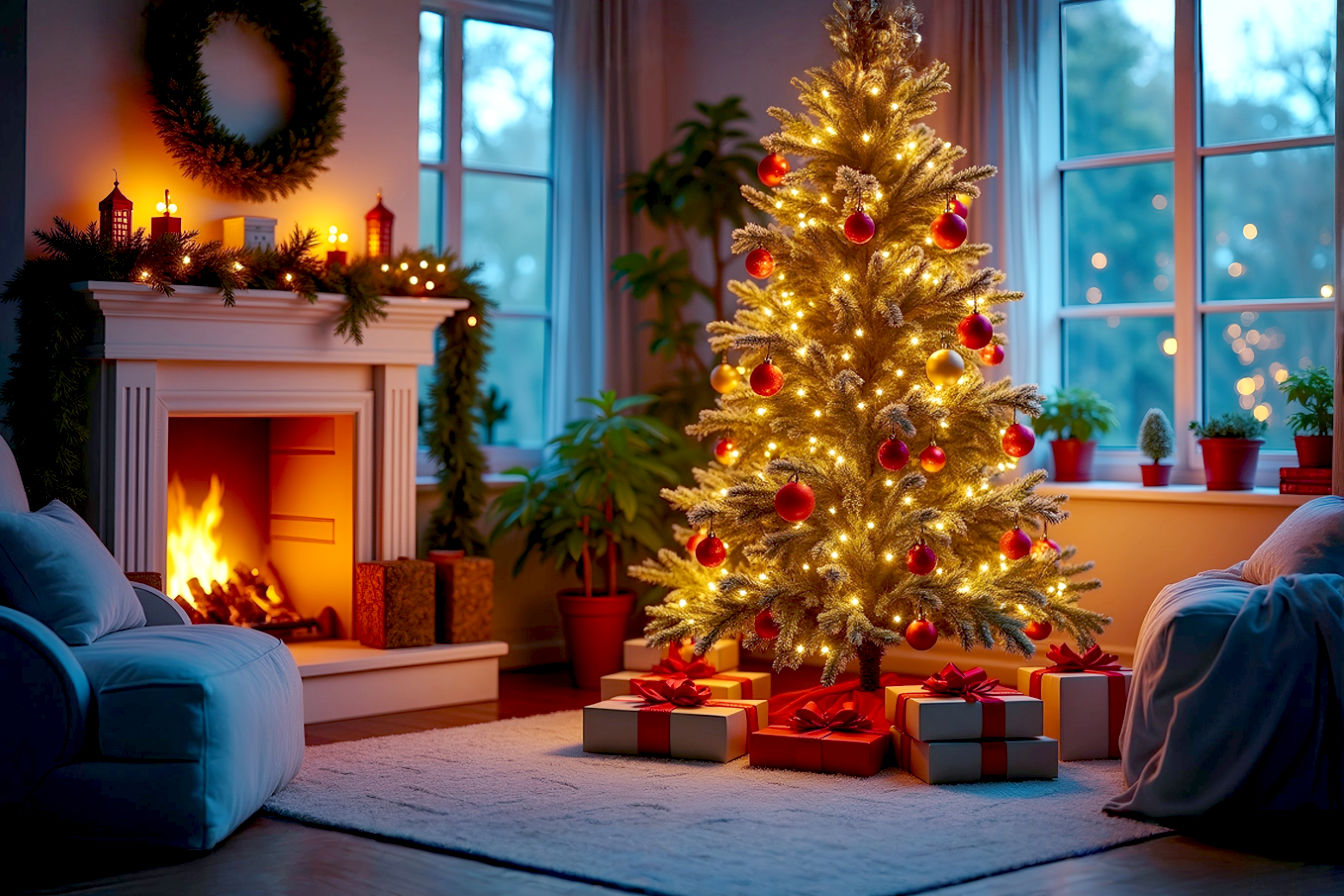This post may contain affiliate links. If you make a purchase through these links, we may earn a commission at no additional cost to you.
The holiday season brings a special kind of magic, and at its heart often stands a beautifully decorated Christmas tree. For generations, people have adorned their trees with lights, transforming them into sparkling beacons of festive cheer. From the earliest candles to the classic incandescent bulbs, Christmas tree lighting has evolved dramatically. Today, LED fairy lights have emerged as the undisputed champion, offering a blend of efficiency, safety, and dazzling visual appeal that traditional lights simply can’t match.
These tiny, brilliant lights don’t just illuminate your tree; they revolutionize how we experience holiday decor. They’re more than just pretty; they’re a smart choice for modern homes. This comprehensive guide will dive deep into the world of LED Christmas tree lights. We’ll explore the fascinating science behind their glow, uncover their many benefits, help you choose the perfect type for your vision, and even share expert tips for installation and troubleshooting. Get ready to unlock the full potential of your holiday display and truly transform your tree.
The Science Behind the Sparkle: How LED Christmas Lights Work
Have you ever wondered what makes LED Christmas lights shine so brightly without getting hot? The secret lies in their innovative technology. Unlike old-fashioned bulbs, LEDs don’t rely on a heated filament. This fundamental difference is what gives them their incredible advantages.
Understanding Light-Emitting Diodes (LEDs): A Closer Look
At their core, LEDs (Light-Emitting Diodes) are tiny, solid-state semiconductor devices. Think of them as miniature electronic components that convert electrical energy directly into light. It’s a much more efficient process than what happens in traditional bulbs.
Simplified Explanation: Imagine a tiny chip that glows when electricity passes through it. That’s essentially what an LED does. When electrons move through this special material, they release energy in the form of light, rather than mostly heat. This means almost all the power goes into making light, not wasted warmth.
Technical Explanation: An LED is built around a P-N junction, which is formed by joining two different types of semiconductor materials. One side, the P-type, has an excess of “holes” (places where electrons are missing), while the N-type side has an excess of free electrons. When you apply a voltage across the LED in the correct direction (forward bias), electrons from the N-type material move across the junction and recombine with the holes in the P-type material. This recombination process releases energy as photons, which are particles of light. This phenomenon is called electroluminescence.
The specific color of the light emitted depends on the band gap energy of the semiconductor material used. For example, gallium arsenide phosphide (GaAsP) produces red or yellow light, while indium gallium nitride (InGaN) is used for blue and green LEDs. White LEDs are typically created by using a blue LED chip coated with a yellow phosphor material. This phosphor absorbs some of the blue light and re-emits it as yellow light. The combination of the remaining blue light and the emitted yellow light appears white to our eyes.
The Anatomy of an LED Christmas Light Strand
A single LED Christmas light strand is more than just a collection of bulbs. It’s a carefully engineered system designed for durability and performance. Understanding its main components helps you appreciate its efficiency.
Components:
- LED Chips: These are the actual light-emitting elements, as described above.
- Resistors: Crucial for managing the electrical current. LEDs are sensitive to voltage, and resistors limit the current flowing through them, protecting them from damage and ensuring consistent brightness. Without resistors, the LEDs would quickly burn out.
- Wiring: Connects all the LEDs and components, carrying the electrical current.
- Controllers: For smart or multi-function lights, a small circuit board acts as a controller. This brain allows for different lighting effects, color changes, and app connectivity.
- Power Supply/Transformer: Converts the standard household AC voltage (e.g., 120V in the US) to the lower DC voltage required by the LEDs. This is usually integrated into the plug or a small box near it.
Series vs. Parallel Circuits: Older incandescent Christmas lights often used a series circuit. This meant if one bulb burned out, the entire strand would go dark, making troubleshooting a nightmare. Many modern LED Christmas lights, however, use a parallel circuit design, or a combination of series-parallel segments. In a parallel circuit, each LED has its own path for electricity. If one LED fails, the others can continue to light up. Some LED strands also incorporate shunt resistors. If an LED fails and creates an open circuit, the shunt resistor activates, bypassing the failed LED and allowing the rest of the circuit to remain lit. This is a significant improvement for reliability and ease of use.
Color Creation in LEDs: From White to RGB
The vibrant spectrum of colors available in LED Christmas lights is a testament to clever engineering. It’s not just about turning a light on; it’s about precisely controlling the light’s wavelength.
Monochromatic LEDs: The simplest LEDs produce a single, fixed color. These are often red, green, or blue, achieved by using specific semiconductor materials that emit light at a particular wavelength. For example, a red LED will always glow red.
White LEDs: Creating white light with LEDs is a bit more complex. As mentioned, most white LEDs use a blue LED chip. This blue light then passes through a layer of phosphor coating. This phosphor absorbs some of the blue light and re-emits it at longer wavelengths, typically yellow. Our eyes then perceive the combination of the remaining blue light and the newly created yellow light as white. The exact shade of white (e.g., warm white with a yellowish tint, or cool white with a bluish tint) depends on the specific phosphor mixture and the intensity of the blue light. Warm white LEDs often have a color temperature around 2700K-3000K, mimicking traditional incandescent bulbs, while cool white LEDs are typically 5000K-6500K, appearing brighter and more modern.
RGB LEDs: For truly dynamic and customizable lighting, RGB LEDs are the answer. An RGB LED actually contains three separate LED chips—one red, one green, and one blue—all housed within a single bulb or package. By independently controlling the brightness of each of these three primary colors, the LED can produce virtually any color in the visible spectrum. For instance, combining red and green light creates yellow, while mixing all three at full brightness produces white. With a sophisticated controller, these RGB LED Christmas lights can cycle through millions of colors, create gradients, and even synchronize with music, offering unparalleled creative possibilities for your Christmas tree lighting.
Why Make the Switch? Unpacking the Benefits of LED Christmas Tree Lights
If you’re still using older incandescent lights, you’re missing out on a host of advantages that LED Christmas tree lights offer. The benefits extend far beyond just pretty illumination. They impact your energy bill, your safety, and even the environment.
Incredible Energy Efficiency: Saving Power, Saving Money
One of the most compelling reasons to choose LED Christmas lights is their remarkable energy efficiency. They use significantly less electricity than their incandescent predecessors, translating directly into lower utility bills during the holiday season.
Comparison with Incandescent: A typical incandescent mini-light bulb consumes about 0.4 to 0.5 watts of power. An equivalent LED mini-light, however, uses only about 0.04 to 0.07 watts. This means LED Christmas lights use up to 90% less energy! Imagine a standard 100-light string: the incandescent version might draw 40-50 watts, while the LED version would draw only 4-7 watts. Over weeks of continuous use, these savings add up substantially.
How LEDs Convert Electricity to Light More Efficiently: The key to this efficiency lies in how LEDs produce light. Incandescent bulbs generate light by heating a filament until it glows. A significant portion of the electrical energy (around 90%) is wasted as heat, with only about 10% converted into visible light. LEDs, through the process of electroluminescence, convert electricity directly into light with very little heat loss. This makes them far more efficient at producing illumination.
Environmental Impact: Beyond saving you money, using energy-efficient LED Christmas lights also reduces your carbon footprint. Lower electricity consumption means less demand on power plants, which in turn leads to fewer greenhouse gas emissions. It’s a small change that contributes to a greener holiday season.
Extended Lifespan: Lights That Last for Seasons
Tired of replacing burnt-out bulbs every year? LED Christmas lights offer a solution with their impressive longevity. Their solid-state design means they’re built to last, providing reliable illumination for many holiday seasons to come.
Durability of LEDs: Unlike fragile incandescent bulbs with their delicate filaments and glass envelopes, LEDs are solid-state devices. They don’t have a filament that can burn out or break. This makes them incredibly durable and resistant to shocks, vibrations, and accidental drops. Many LED Christmas bulbs are also made with shatter-resistant plastic lenses, further enhancing their robustness.
Typical Lifespan: The average lifespan of an incandescent Christmas light bulb is typically between 1,000 and 3,000 hours. In stark contrast, LED Christmas lights are rated for 25,000 to 50,000 hours, and some even longer. This means a single string of quality LED lights could last for decades, even with daily use during the holiday season. Think about it: if you run your lights for 6 hours a day for 30 days during December, that’s 180 hours per season. An LED string rated for 50,000 hours would theoretically last for over 277 seasons!
Reduced Waste and Replacement Costs: The extended lifespan of LED fairy lights means less waste going into landfills from discarded bulbs. It also saves you the time, effort, and money associated with constantly buying replacement bulbs or entirely new strands. It’s an investment that pays off over time.
Enhanced Safety: Cooler to the Touch
Safety is paramount, especially during the festive season when homes are filled with family and flammable decorations. LED Christmas tree lights offer a significant safety advantage over traditional lights.
Minimal Heat Emission: This is a critical difference. Incandescent bulbs generate a considerable amount of heat because of their inefficient light production process. They can become quite hot to the touch, posing a burn risk and, more importantly, a potential fire hazard when in contact with dry Christmas tree needles, paper decorations, or fabrics. LEDs, however, produce very little heat. You can touch an illuminated LED bulb, and it will feel cool or only slightly warm.
Reduced Fire Risk: The low heat output of LED Christmas lights dramatically reduces the risk of accidental fires. This is a major concern, particularly with real Christmas trees, which can dry out over time and become highly flammable. Using cooler-burning LEDs provides peace of mind.
Safer for Children and Pets: Because they don’t get hot, LED lights are much safer for curious little hands or playful pets who might accidentally brush against or chew on the lights. There’s less risk of burns or other heat-related injuries.
Durability and Robustness: Built to Withstand the Elements
Beyond their long lifespan, LED Christmas lights are inherently more durable than their older counterparts. Their construction makes them resilient to the bumps and knocks of holiday decorating and even harsh weather conditions.
Shatter-Resistant Bulbs: Many LED Christmas lights feature bulbs made from durable plastic or epoxy, rather than fragile glass. This makes them highly resistant to shattering if dropped or if a branch falls on them. This is especially beneficial for outdoor installations or in homes with active children or pets.
Resistance to Vibration and Impact: The solid-state nature of LEDs means they have no delicate filaments to break from vibration or impact. This makes them ideal for high-traffic areas or for trees that might be moved.
Suitable for Both Indoor and Outdoor Use: While always check the product’s IP (Ingress Protection) rating for outdoor use, many LED Christmas lights are designed to be weather-resistant. An IP44 rating, for instance, indicates protection against solid objects larger than 1mm and splashing water from any direction, making them suitable for general outdoor conditions. Higher ratings like IP65 offer even greater protection against dust and water jets. This versatility means you can use the same type of reliable lighting for your indoor tree and your outdoor displays.
Vibrant Colors and Dynamic Effects: A Visual Feast
Beyond practical benefits, LED Christmas lights truly excel in their aesthetic capabilities. They offer a richer, more diverse palette of colors and a wider range of dynamic effects, allowing for truly spectacular displays.
Purer, Brighter Colors: LEDs produce light in very specific wavelengths, resulting in purer, more saturated colors compared to the often muted or yellowish hues of incandescent bulbs. Reds are richer, blues are deeper, and greens are more vibrant. This makes your Christmas tree lighting pop with intense, eye-catching brilliance.
Ability to Create Various Lighting Effects: The electronic nature of LEDs makes them highly controllable. This opens up a world of dynamic lighting effects that were difficult or impossible with traditional lights. You can find twinkling LED Christmas lights that sparkle like distant stars, lights that slowly fade in and out, chasing effects that create a sense of movement, and even sophisticated color-changing patterns.
Programmable Options for Custom Displays: With the advent of smart LED lights, the possibilities are virtually limitless. You can program custom sequences, choose from pre-set animations, or even design your own unique light shows. This level of customization allows you to create a truly personalized and memorable holiday display that reflects your style.
Choosing Your Glow: Types of LED Fairy Lights for Christmas Trees
The world of LED fairy lights for Christmas trees is vast and varied, offering options for every taste and budget. Knowing the different types available will help you select the perfect lights to achieve your desired aesthetic.
Traditional String Lights: Classic Look, Modern Tech
These are the most common type of LED Christmas lights, designed to mimic the familiar appearance of traditional incandescent strands but with all the benefits of LED technology. They come in various bulb shapes and sizes.
- Mini LEDs: These are the smallest and most common, offering a subtle, delicate sparkle. They are perfect for wrapping densely around branches to create a full, glowing effect.
- C6 Bulbs: Shaped like a strawberry, these are slightly larger than mini LEDs and offer a distinct, faceted look that catches the light beautifully. They’re a popular choice for a classic yet modern feel.
- C7 and C9 Bulbs: These are larger, traditional-shaped bulbs (C7 is candelabra base, C9 is intermediate base) that provide a more prominent, vintage look. While larger, their LED versions still consume far less power than their incandescent counterparts. They’re excellent for outlining your tree or for outdoor displays where you want a bolder statement.
These traditional string lights are versatile and can be found in warm white LED Christmas lights (mimicking the soft glow of incandescent), cool white LED Christmas lights (a brighter, more modern look), or multi-color options.
Net Lights: Effortless Coverage for Bushes and Trees
If you’re looking for a quick and easy way to cover a large area with uniform light, net lights are an excellent choice. They consist of a grid of lights that can be draped over bushes, shrubs, or even small, uniformly shaped Christmas trees.
Pre-arranged Grid: The main advantage of net lights is their pre-arranged pattern. You simply unroll them and place them over the desired area. This saves a significant amount of time and effort compared to individually wrapping string lights. They provide consistent spacing and brightness across the entire surface.
Best for Uniform Coverage: While not ideal for intricate tree wrapping, net lights are perfect for achieving a dense, even glow on a tree or bush. They ensure every part of the surface is illuminated equally, creating a striking, solid block of light.
Icicle Lights: Creating a Winter Wonderland Effect
For a magical, cascading look that evokes falling snow or shimmering ice, icicle lights are the perfect choice. These strands feature varying drop lengths, creating a dynamic, layered effect.
Varying Drop Lengths: Icicle lights consist of a main horizontal wire from which vertical “drops” of lights hang down. These drops vary in length, typically from a few inches to a couple of feet, creating a natural, irregular appearance. When hung on a tree, they give the impression of glistening icicles or shimmering waterfalls of light.
They are particularly effective when draped along the outer edges of a tree or used to create a “snowy” effect on branches.
Projector Lights: Dazzling Displays with Minimal Effort
While not “fairy lights” in the traditional sense, projector lights offer a unique and impactful way to illuminate your Christmas tree, especially if it’s an outdoor one. They project patterns, images, or even animated scenes onto a surface.
Projecting Patterns or Images: Instead of wrapping individual lights, a projector light sits on the ground and beams light onto your tree or home. These can create effects like falling snowflakes, swirling stars, or even festive characters. They offer a large-scale display with minimal setup time.
Often Used for Outdoor Trees: Due to their projection nature, they are most effective on larger outdoor trees or the exterior of your house. They can complement traditional string lights, adding an extra layer of visual interest and movement to your Christmas tree lighting.
Battery-Operated LED Lights: Flexibility for Any Location
For areas without convenient access to power outlets, or for smaller, portable decorations, battery-operated LED lights are an invaluable solution. They offer ultimate flexibility in placement.
Ideal for Wreaths, Garlands, Small Trees: These lights are perfect for adorning wreaths on doors, winding around banisters, decorating small tabletop Christmas trees, or adding sparkle to centerpieces. Their lack of a power cord means you can place them virtually anywhere.
Considerations: Battery Life, Brightness: The main trade-offs with battery-operated lights are battery life and sometimes brightness. Higher quality lights will use more efficient LEDs and offer longer battery life. Look for models with timers to conserve power, automatically turning off after a set number of hours. Some even come with remote controls for easy operation.
Smart LED Christmas Lights: The Future of Festive Illumination
The most advanced and exciting category of LED Christmas lights are smart LED Christmas lights. These lights integrate with technology, allowing for unprecedented control and customization, truly transforming your Christmas tree lighting experience.
App-Controlled Features: The hallmark of smart lights is their ability to be controlled via a smartphone or tablet app. This unlocks a wealth of features:
- Color Changing: Easily switch between millions of colors with a tap.
- Dimming: Adjust the brightness to set the perfect mood.
- Scheduling: Program lights to turn on and off automatically at specific times.
- Music Synchronization: Some advanced smart LED Christmas lights can even sync their patterns and colors to the beat of your favorite holiday music, creating an immersive light show.
- Pre-set Effects: Choose from a library of dazzling animations like waves, rainbows, or cascading effects.
Integration with Smart Home Systems: Many smart LED Christmas lights can integrate with popular smart home platforms like Amazon Alexa, Google Home, or Apple HomeKit. This means you can control your lights with voice commands, or incorporate them into broader smart home routines. “Alexa, turn on the Christmas tree lights!” is a common and convenient command.
How Wi-Fi/Bluetooth Connectivity Works: These lights typically connect to your home network via Wi-Fi or directly to your smartphone via Bluetooth.
- Wi-Fi Connectivity: Lights connect to your home’s Wi-Fi router, allowing you to control them from anywhere with an internet connection. This is common for larger, more integrated systems.
- Bluetooth Connectivity: Lights connect directly to your smartphone via Bluetooth, offering local control within a certain range. This is often found in simpler, more affordable smart light sets.
Popular brands like Twinkly and Philips Hue offer sophisticated smart Christmas lighting solutions, allowing you to map individual LEDs on your tree for highly detailed and personalized effects. This level of control truly elevates your Christmas tree lighting to an art form.
Mastering the Art of Illumination: How to Light Your Christmas Tree with LEDs
Lighting a Christmas tree isn’t just about throwing lights on it. To achieve that truly magical, professional look, a little planning and technique go a long way. With LED Christmas lights, you have the tools to create a stunning display.
Planning Your Lighting Scheme: Quantity and Color
Before you even unbox your lights, take a moment to plan. The right quantity and color choice are crucial for the overall effect.
Rule of Thumb for Light Count: A widely accepted guideline is to use 100 lights per foot of tree height. So, an 8-foot tree would ideally need around 800 lights. For a denser, more brilliant look, you might even consider 150 lights per foot. Don’t be afraid to go higher if you want a truly spectacular, glowing tree. A fuller tree will require more lights to achieve the same brightness as a sparser one.
Considering Tree Density and Desired Brightness: A very dense, bushy tree will absorb more light, so you might need more strands to ensure even illumination. If you prefer a subtle, elegant glow, you can stick to the lower end of the light count. For a dazzling, show-stopping tree, aim for the higher end.
Warm White vs. Cool White vs. Multi-Color: Choosing the Right Ambiance:
- Warm White LED Christmas Lights: These emit a soft, yellowish glow, closely mimicking the traditional warmth of incandescent bulbs. They create a cozy, nostalgic, and inviting ambiance. They pair beautifully with classic red and gold ornaments.
- Cool White LED Christmas Lights: These emit a brighter, slightly bluish-white light. They offer a crisp, modern, and icy look, perfect for silver, blue, or contemporary decorations. They can make your tree feel like a winter wonderland.
- Multi-Color LED Christmas Lights: These offer a festive, playful, and vibrant look. They are ideal for families with children or anyone who loves a lively, traditional Christmas palette. With RGB LED Christmas lights, you can even switch between these color schemes at will.
Installation Techniques: Wrapping for a Professional Look
How you put the lights on your tree makes a huge difference. There are a couple of popular methods to achieve a full, even glow.
Vertical Wrapping vs. Horizontal Wrapping:
- Vertical Wrapping (The “Zig-Zag” Method): This technique involves starting at the top of the tree and stringing lights vertically down to the bottom, then moving over a few inches and stringing them back up. You repeat this zig-zag pattern around the tree. This method is great for ensuring even coverage from top to bottom and is often preferred for artificial trees with distinct sections.
- Horizontal Wrapping (The “Spiral” Method): This is perhaps the most common method. You start at the top or bottom of the tree and spiral the lights around the tree, working your way up or down. As you spiral, push some lights deeper into the branches for depth and keep others closer to the tips. This creates a beautifully integrated look.
Working from the Inside Out for Depth: For a truly professional and dimensional look, don’t just wrap lights around the outside of the branches. Start by stringing some lights closer to the trunk, deep within the tree. This creates an inner glow that makes the tree appear lit from within, adding incredible depth and richness to your Christmas tree lighting. Then, layer more lights on the outer branches.
Securing Lights Without Damaging Branches: For artificial trees, you can often gently twist the branches around the light wires to hold them in place. For real trees, simply lay the wires on the branches. Avoid pulling the wires too tightly, which can damage the lights or the tree. If needed, use floral wire or small zip ties that match the branch color to discreetly secure sections, especially on sparse branches or for heavy light strands.
Layering Lights for Depth and Dimension
The most stunning Christmas trees often use more than one type of light or light placement. Layering adds visual interest and makes your tree truly sparkle.
Using Different Types of Lights: Consider combining different sizes or styles of LED Christmas lights. For example, you might use smaller mini LEDs deep inside the tree for that inner glow, and then use larger C7 or C9 bulbs on the outer branches for a bolder statement. This contrast in size adds visual texture.
Combining Steady Lights with Twinkling Lights: For a dynamic effect, use a base layer of steady, non-blinking lights for overall illumination. Then, add a separate strand of twinkling LED Christmas lights or lights with a subtle fading effect on top. This creates movement and sparkle without being overwhelming. Some smart LED Christmas lights allow you to program different sections of your tree with different effects, achieving this layered look with a single set of lights.
Safety First: Essential Tips for LED Christmas Lights
While LED Christmas lights are inherently safer than incandescent lights, it’s still crucial to follow basic safety guidelines to ensure a worry-free holiday season.
Checking for UL Listing: Always look for the UL (Underwriters Laboratories) listing on the packaging. This certification indicates that the lights have been tested for safety standards. A UL mark means the product meets specific safety requirements.
Proper Outdoor vs. Indoor Usage: Not all LED lights are rated for outdoor use. Lights intended for outdoor use will have a specific IP rating (e.g., IP44, IP65) indicating their resistance to dust and water. Never use indoor-only lights outdoors, as they are not designed to withstand moisture, which can lead to electrical hazards.
Avoiding Overloading Circuits: While LEDs are highly energy-efficient, it’s still possible to overload an electrical circuit if you connect too many strands or other high-wattage decorations to a single outlet. Always check the maximum wattage for your circuit and extension cords. LEDs allow you to connect many more strands end-to-end than incandescent lights (often 40-50 strands compared to 3-5 incandescent strands), but it’s still wise to distribute lights across different outlets if you have a massive display.
Inspecting Wires for Damage: Before putting up your lights each year, carefully inspect the entire strand. Look for frayed wires, cracked insulation, loose connections, or damaged bulb sockets. Damaged lights should be repaired by a qualified person or discarded. Never use lights with exposed wires.
Storing Lights Properly: Proper storage significantly extends the life of your LED Christmas lights and prevents damage. Wind them neatly around a reel, a piece of cardboard, or a plastic hanger. Avoid tangling them, which can stress wires and connections. Store them in a cool, dry place away from pests and extreme temperatures.
Troubleshooting Common LED Christmas Light Issues
Even with the reliability of LED Christmas lights, occasional issues can arise. Knowing how to troubleshoot common problems can save you frustration and keep your holiday display shining brightly.
When a Section Goes Out: Understanding Circuit Design
One of the most common issues is a section of lights going dark. While frustrating, it’s often easier to fix with LEDs than with old incandescent lights.
Unlike Incandescent, Often a Single LED Failure Doesn’t Take Out the Whole Strand: This is a key advantage of modern LED light strands. Older incandescent strings were often wired in series, meaning if one bulb failed, the entire circuit was broken, and the whole string went dark. Many LED Christmas lights are wired in parallel, or in smaller series segments with bypass mechanisms. This means a single failed LED usually won’t cause the entire strand to fail.
Identifying the Faulty Bulb: If a section is out, carefully inspect each bulb in that section. Look for:
- Physical Damage: A cracked lens, a loose bulb, or a bent wire.
- Discoloration: A discolored or burnt-looking LED (though less common with LEDs).
- Using a Light Tester: For more precise troubleshooting, you can purchase an LED light tester. These devices can detect breaks in the circuit and often have a probe to test individual bulbs. They work by sending a small current through the wire or bulb and indicating if the circuit is complete.
How Shunt Resistors Bypass a Failed LED: Many LED light strings incorporate shunt resistors (also known as bypass resistors) within each LED bulb. If the LED itself fails and creates an open circuit (meaning electricity can’t flow through it), the shunt resistor automatically creates an alternative path for the current to flow around the failed LED. This allows the rest of the lights in that section to remain lit, even if one LED is out. While the failed LED won’t light up, the rest of the strand continues to function, making troubleshooting much simpler. You just need to replace the single faulty bulb.
Flickering or Dimming Lights: Power and Connection Problems
If your LED Christmas lights are flickering or appear dimmer than usual, it often points to a power or connection issue rather than a widespread bulb failure.
Loose Connections: The most common culprit is a loose connection. Check all plugs, including where strands connect end-to-end, and where the main plug connects to the outlet. Even a slightly loose connection can cause intermittent power.
Power Supply Issues: The power adapter (the small box on the plug) converts AC to DC. If this adapter is faulty or damaged, it can lead to inconsistent power delivery, causing flickering or dimming. Try plugging the strand into a different outlet or using a different adapter if you have one available.
Voltage Drops: If you have a very long run of lights, especially if you’ve connected many strands together, there might be a slight voltage drop towards the end of the run. This can cause the lights furthest from the power source to appear slightly dimmer. This is less common with modern, efficient LEDs but can still occur in very extensive setups. Using heavier gauge extension cords can help.
Smart Light Connectivity Issues: Wi-Fi and App Troubleshooting
Smart LED Christmas lights add a layer of complexity with their connectivity. If your app isn’t controlling your lights, here’s what to check.
Router Distance, Interference: Smart lights rely on Wi-Fi or Bluetooth. If your lights are too far from your Wi-Fi router, or if there’s significant interference from other devices (like microwaves, cordless phones, or other Wi-Fi networks), the connection can be unstable. Try moving the router closer or reducing interference.
App Updates: Ensure your smart light app is updated to the latest version. Developers frequently release updates to fix bugs and improve performance.
Resetting Lights and Reconnecting: Often, the simplest solution is to perform a factory reset on your smart lights (check the manufacturer’s instructions for how to do this) and then go through the pairing process again within the app. This can resolve many connectivity glitches. Also, ensure your phone’s Bluetooth is on if the lights use Bluetooth, and that your Wi-Fi network is active and stable.
Beyond the Tree: Creative Uses for LED Fairy Lights Year-Round
The magic of LED fairy lights isn’t limited to the Christmas tree. Their versatility, energy efficiency, and cool-to-the-touch nature make them perfect for adding sparkle and ambiance to your home throughout the entire year.
Decorating Mantels, Doorways, Windows
LED fairy lights can instantly elevate everyday decor. Drape them along a mantelpiece with garland for a cozy glow, weave them through a staircase banister, or outline windows for a charming effect. Their small size and flexibility allow them to be tucked into almost any space, adding a subtle touch of warmth and light. You can even use them to highlight artwork or shelving.
Creating Ambient Lighting in Bedrooms or Patios
These lights are fantastic for setting a mood. In a bedroom, string them behind a headboard, around a mirror, or across a wall to create a soft, ethereal glow perfect for relaxation. On a patio or deck, outdoor-rated LED fairy lights strung overhead can transform the space into an inviting oasis for evening gatherings. They provide just enough light without being harsh, fostering a comfortable and magical atmosphere.
Adding Sparkle to Special Events
Whether it’s a birthday party, a wedding, or a casual backyard barbecue, LED fairy lights can add a touch of enchantment to any celebration. Use them as table centerpieces, string them through floral arrangements, or create illuminated backdrops for photos. Their low power consumption means they can run for hours, ensuring your event remains beautifully lit from start to finish. Battery-operated versions are particularly useful for events where power outlets are scarce.
Conclusion: Embrace the Brilliance of LED Christmas Tree Lights
The journey from flickering candles to sophisticated LED Christmas tree lights has been remarkable. What started as a practical innovation has blossomed into a truly magical transformation for our holiday decor. We’ve explored the fascinating science behind these tiny powerhouses, understanding how they convert electricity into pure, vibrant light with incredible efficiency.
The benefits of making the switch are clear and compelling. LED Christmas lights offer unparalleled energy efficiency, significantly reducing your electricity bills and environmental impact. Their extended lifespan means you’ll enjoy them for many seasons, cutting down on waste and replacement costs. Crucially, their enhanced safety due to minimal heat emission provides peace of mind, especially in homes with children or pets. Add to that their durability and the stunning array of vibrant colors and dynamic effects they can produce, and it’s easy to see why they’ve become the gold standard for holiday illumination.
From traditional string lights that evoke classic charm to the cutting-edge capabilities of smart LED Christmas lights that you can control with your phone, there’s an LED solution for every vision. Mastering installation techniques, like layering and strategic placement, will help you achieve a truly professional and dazzling display. And should an issue arise, understanding basic troubleshooting can quickly get your lights shining brightly again.
So, this holiday season, embrace the brilliance. Upgrade your Christmas tree lighting with LED fairy lights. Experiment with colors, effects, and placement. You’ll create a stunning visual centerpiece and enjoy the practical advantages that come with modern, efficient, and safe illumination. Let the magic of LED technology transform your tree into a beacon of holiday joy and sparkle for years to come.

